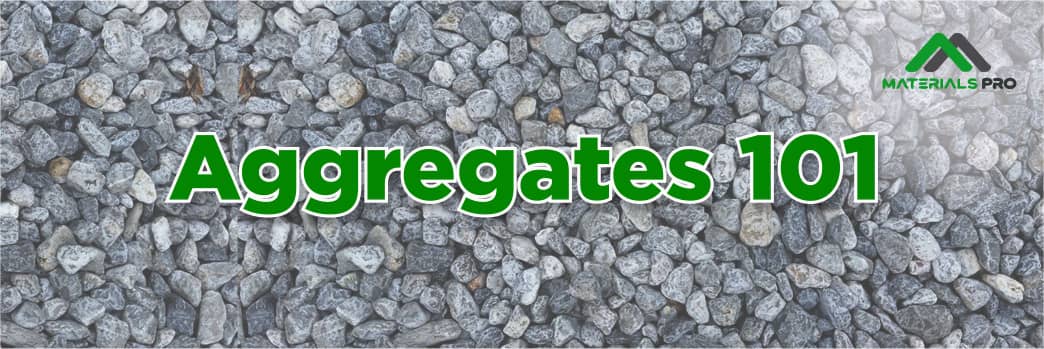What You Need To Know About Aggregates
MaterialsPro
Oct 18, 2022 - 5 minutes
What comes to your mind when you hear the word AGGREGATES? Well, it is simple!
Aggregates is a category of fine to coarse-grained granular particles, including sand, gravel or granite, used for construction purposes. Aggregates account for 60% to 75% of the total volume of concrete.
Good quality aggregate material is a fundamental building block for any construction type. This could be anything from houses, roads, and pavements; the aggregates work as a glue which binds structural elements together.
Aggregates directly and significantly impact the strength, workability, and durability of freshly mixed and hardened concrete; therefore, selecting aggregates is an important process in making concrete.
Aggregates in building and construction
Aggregates remarkably affect the properties of fresh and hardened concrete based on their shape, size, texture, grading and crushing value. They essentially lower cracks and emphasise how strong the specific structure is. As a whole, ‘aggregate’ is a term used to describe gravels, sands or crushed-up stones(also known as granites), which can be classified as coarse or fine.
Different aggregates used in construction:
Aggregates are classified in three ways: Grain Size, Unit Weight, Geological Origin, and Shape.
Classification of aggregates based on their grain size:
- Fine Aggregate: Aggregates that pass through a 4.75mm sieve are classified as Fine Aggregates. They are natural sand, crushed stone and crushed gravel stone. The minimum size of fine aggregates can be 0.06 mm.
- Coarse Aggregate: Aggregates retained on a 4.75mm sieve are known as Coarse Aggregates. They are obtained by natural fragmentation or by artificially crushing the rocks. The maximum size of coarse aggregate can be 80 mm.
Classification of aggregates based on their unit weight:
- Lightweight Aggregate: These are natural or synthetic aggregates that weigh less than 1100 kg/m3 Cinder, clay, dolomite and pumice are considered Lightweight aggregates.
- Normal weight Aggregate: Sand, gravel, granite, and limestone can be considered Normal Weight aggregates.
- Heavyweight Aggregate: These are aggregates with high density and are used when high-density concrete is necessary. Generally, aggregates with a specific gravity of 2400 Kg/m3 and higher are considered heavyweight. Scrap iron, magnetite and baryte are heavyweight aggregates.
Classification of aggregate based on their geological origin:
- Natural Aggregate: These are aggregates obtained from naturally obtained rocks. Sand and gravel fall into this type of aggregates.
- Artificial Aggregate: Blast Furnace Slag, Broken Bricks, and Synthetic aggregates are Artificial Aggregates.
- Blast furnace slag aggregate is formed by slow cooling of slag followed by crushing and is used for making precast concrete products.
- Broken bricks are used in foundations for mass concreting and are not recommended for reinforced concrete works.
- Synthetic aggregates are made from thermally processed materials like expanded clay and shale.
Classification of aggregates based on their shape:
- Rounded Aggregate: These aggregates are round due to the friction of water. They are obtained from rivers and seashores.
- Irregular Aggregate: These aggregates are irregular and thus have a strong locking bond. So, these are used for making ordinary concrete.
- Angular Aggregate: These aggregates are rough, sharp, and angular, providing a solid bond. These are recommended for use in the construction of pavements.
- Flaky and Elongated Aggregate: These aggregates are generally rough and sharp.
- When the aggregate thickness is smaller than its width and length, it is said to be flaky.
- It is called elongated aggregate when its length is larger than its width and thickness.
- When the aggregate length is larger than its width and the width is larger than its thickness, it is said to be flaky and elongated aggregates.
Properties of aggregates:
- Composition
- Size & Shape
- Surface Texture
- Specific Gravity
- Bulk Density
- Voids
- Porosity & Absorption
- Bulking of Aggregate
- Fineness Modulus of Aggregate
- Surface Index of Aggregate
- Deleterious Material
- Crushing Value of Aggregate
- Impact Value of Aggregate
- Abrasion Value of Aggregate
With aggregates comprising 60 to 75% of concrete’s constituents, their role and importance in construction cannot be over-emphasized. Therefore, there is a need to understand the various aggregates to make an informed decision on which is suitable for different construction types.
That is why we are here to keep you updated on all aggregate-related information you need. Don’t be a stranger; stay connected and share the link with your friends and colleagues.

